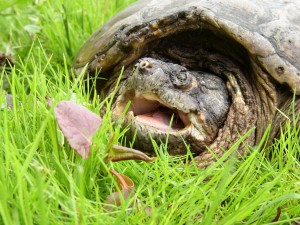“Go ahead, I dare you,” my brother Jimmy snickered to me. “It won’t hurt you,” he said staring at the gnarly-looking beast from the deep, which had just crawled out of the lake. It was at that exact moment when the ticked off reptile flung its large head and ferocious jaws at my hand, just missing my little finger! However, it did manage to SNAP the one inch stick I was holding, in half, like a thin toothpick. Jimmy just stood there laughing, as if he was trying to demonstrate a hard, nature lesson, from a tricky older brother, to a defenseless baby brother! OK, I got it, just like you assured me six months earlier that the old wire fence around that overgrown pasture was not electric!
The “beast’ is a common critter in Pennsylvania, but mysterious. Most of the time it stays hidden underwater, in a lake, pond or slow-moving river. It’s a prehistoric animal, having been swimming and crawling on earth for millions of years. What it lacks in teeth, it easily makes up for with a sharp beak and very powerful jaws. The creature from under the surface is a Common Snapping Turtle, one of two species of snapping turtles that live in the U.S. The other is an Alligator Snapping Turtle, an even bigger and scarier reptilian monster that lives in the southern states.
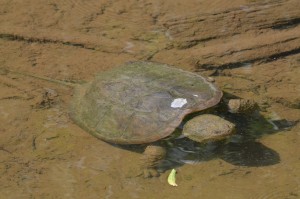
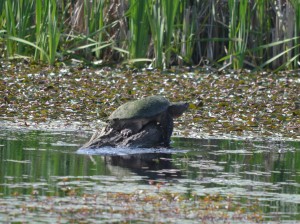 Common Snapping Turtles can weigh up to 40 pounds and some may exceed 50 pounds. Snappers, as they’re commonly called, prefer still or slow-moving freshwater. They like muddy or sandy bottoms with a lot of vegetation. They’re opportunistic feeders, eating a variety of things, including vegetation, dead fish, worms, crayfish, frogs and anything else they want. They spend most of their time laying on the bottom of a pond or lake or floating just below the surface with just their eyes and nose sticking out of the water. On many occasions, I’ve been out fishing in my boat when I glanced over to see a dark, creepy snout with beady little eyes staring back at me. As I try to move closer for a better look, the eerie-looking object quietly disappears into the dark water. These animals are shy and reclusive in the water, usually fleeing when humans approach. But when they are on land (usually females seeking to lay eggs), they have a low tolerance for humans, or other animals, if approached. They have the ability to extend their neck and head out a long way, and quickly-like a snake striking its prey. Even their scientific name, serpentina, means “snake-like.” If you’re within their range, those powerful jaws and sharp beak can inflict a serious injury!
Common Snapping Turtles can weigh up to 40 pounds and some may exceed 50 pounds. Snappers, as they’re commonly called, prefer still or slow-moving freshwater. They like muddy or sandy bottoms with a lot of vegetation. They’re opportunistic feeders, eating a variety of things, including vegetation, dead fish, worms, crayfish, frogs and anything else they want. They spend most of their time laying on the bottom of a pond or lake or floating just below the surface with just their eyes and nose sticking out of the water. On many occasions, I’ve been out fishing in my boat when I glanced over to see a dark, creepy snout with beady little eyes staring back at me. As I try to move closer for a better look, the eerie-looking object quietly disappears into the dark water. These animals are shy and reclusive in the water, usually fleeing when humans approach. But when they are on land (usually females seeking to lay eggs), they have a low tolerance for humans, or other animals, if approached. They have the ability to extend their neck and head out a long way, and quickly-like a snake striking its prey. Even their scientific name, serpentina, means “snake-like.” If you’re within their range, those powerful jaws and sharp beak can inflict a serious injury!
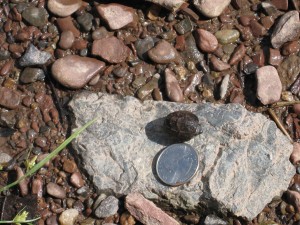
Contrary to popular belief, Snapping turtles are beneficial to our environment. They are efficient scavengers in nature, eating a lot of dead and decomposing animals. Females will leave the water in May and June to find a suitable nesting location (sandy or loose dirt, mulch, leaf litter) where they’ll dig a burrow and lay as many as 50 eggs. Baby snappers will hatch in about 2-3 months, depending on the temperature. Then, if they were lucky enough to hatch, they will attempt to crawl back to the water to live their life, if not eaten by predators such as raccoons, fox or crows, or get run over by a car trying to cross a road. If they make it back to the water, a Snapping turtle can live in the wild for 25 years or more.
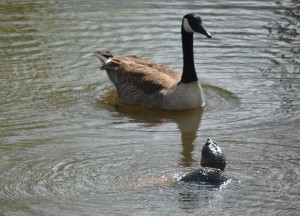
Snapping turtles certainly can live up to their name, but these animals play a valuable part in nature and are important part of the food chain. But, one word of caution, “stop” before you stick your hand near that head and powerful set of jaws-especially if you have a big brother watching with a smirk on his face!
